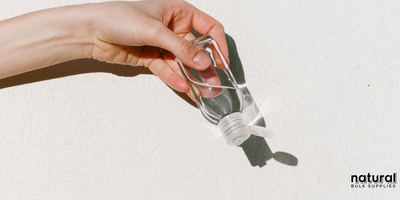Comparing Isopropyl Myristate (IPM) and Isopropyl Palmitate (IPP) – Which One is Best for Your Formulation?
Posted by Natural Bulk Supplies on on Sep 25th 2024
Comparing Isopropyl Myristate (IPM) and Isopropyl Palmitate (IPP): Which One Is Best for Your Formulation?
In cosmetic and personal care formulations, Isopropyl Myristate (IPM) and Isopropyl Palmitate (IPP) are two leading emollient esters that deliver a lightweight, non-greasy texture to both skincare and haircare products. While similar in feel and function, they differ slightly in structure and performance. Understanding the difference helps formulators choose the right ingredient for their desired results.
What Is Isopropyl Myristate (IPM)?
Isopropyl Myristate is a low-viscosity ester formed from isopropyl alcohol and myristic acid. It’s well-known in cosmetics for its fast absorption and silky finish.
In skincare, IPM functions as a penetration enhancer, helping active ingredients reach deeper layers for improved effectiveness. It also helps reduce greasiness from oils and emollients, giving products a smoother, lightweight feel.
Key Benefits of Isopropyl Myristate:
- Non-Greasy Texture: Creates lightweight, smooth formulations.
- Quick Spreadability: Enhances product glide and application.
- Penetration Enhancer: Boosts delivery of actives into the skin.
- Versatility: Used in lotions, serums, and deodorants for a refined feel.
However, isopropyl myristate can be comedogenic, especially in higher concentrations. The isopropyl myristate comedogenic rating is typically 4 out of 5, which means it may clog pores for acne-prone skin if not balanced with lighter ingredients.
What Is Isopropyl Palmitate (IPP)?
Isopropyl Palmitate is an ester of isopropyl alcohol and palmitic acid. It delivers a light, velvety texture to formulations and works effectively as a skin-conditioning agent. Unlike IPM, isopropyl palmitate for skin is often used for its ability to reduce tackiness and improve sensory feel.
Key Benefits of Isopropyl Palmitate:
- Reduces Greasiness: Mitigates oily residue from emollients and butters.
- Skin Conditioning: Creates a silky, soft feel on the skin.
- Fast Absorbing: Provides a quick-dry, smooth finish.
- Ideal for Sensitive Skin: When blended, isopropyl palmitate’s comedogenic rating decreases, making it suitable for acne-prone and sensitive skin.
Formulators often choose isopropyl palmitate for hair care products as it enhances manageability, reduces static, and provides a polished, frizz-free finish.
IPM vs IPP: Key Differences
|
Feature |
Isopropyl Myristate (IPM) |
Isopropyl Palmitate (IPP) |
|
Origin |
Isopropyl alcohol + Myristic acid |
Isopropyl alcohol + Palmitic acid |
|
Primary Function |
Penetration enhancer |
Skin conditioner |
|
Comedogenic Rating |
4 (high) |
2–3 (moderate to low when blended) |
|
Best For |
Deep absorption & lightweight formulas |
Silky texture & reduced tackiness |
|
Skin Type Suitability |
Normal to dry |
Sensitive, acne-prone |
FAQs About IPM and IPP
1. What’s the difference between Isopropyl Myristate and Isopropyl Palmitate?
Both are lightweight esters that reduce greasiness in formulations. IPM acts primarily as a penetration enhancer, while IPP provides conditioning and softness.
2. Is Isopropyl Myristate good for acne-prone skin?
Not usually. Because of its higher comedogenic rating, IPM may clog pores if used in concentrated amounts. For acne-prone or sensitive skin, isopropyl palmitate is generally the safer option, especially when combined with lighter emollients.
3. What is the Isopropyl Palmitate comedogenic rating?
The comedogenic rating of isopropyl palmitate typically ranges from 2–3, which means it has a low to moderate chance of clogging pores, especially when formulated properly.
4. How do I use Isopropyl Myristate and Isopropyl Palmitate in formulations?
- Isopropyl Myristate (IPM): Use at 1–5% in lotions, serums, or creams for a non-greasy, fast-absorbing effect.
- Isopropyl Palmitate (IPP): Use at 1–10% in creams, conditioners, or shampoos for a silky, conditioning finish.
5. Can I use Isopropyl Myristate and Isopropyl Palmitate for hair?
Yes. Both ingredients enhance hair smoothness and manageability. Isopropyl myristate for hair adds softness and shine, while isopropyl palmitate helps reduce static and improves glide in conditioners and styling products.
Applications in Formulations
For Isopropyl Myristate (IPM):
- Lotions & Creams: Reduces heaviness in rich formulations.
- Deodorants: Minimizes white residue and tackiness.
- Hair Serums: Enhances slip and smoothness without buildup.
For Isopropyl Palmitate (IPP):
- Shampoos & Conditioners: Adds silkiness and improves spreadability.
- Body Lotions: Delivers a non-tacky, hydrated finish.
- Lip Products: Creates a smooth, non-sticky feel for balms and glosses.
Final Thoughts
Both isopropyl myristate and isopropyl palmitate are excellent emollients for personal care formulations.
- Choose IPM if your goal is to enhance absorption and light texture.
- Choose IPP if you want conditioning, softness, and lower comedogenicity—especially for sensitive or acne-prone skin.
Whether for skin or hair care, both ingredients elevate the sensory quality and performance of cosmetic formulations.

